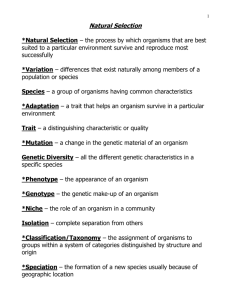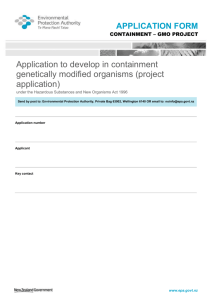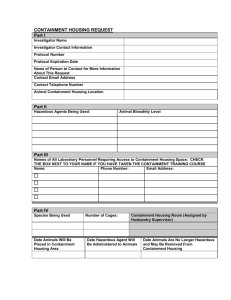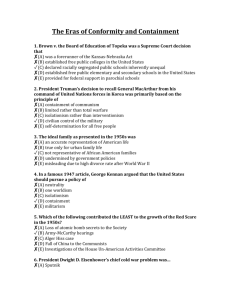ENVIRONMENTAL RISK MANAGEMENT AUTHORITY DECISION
advertisement
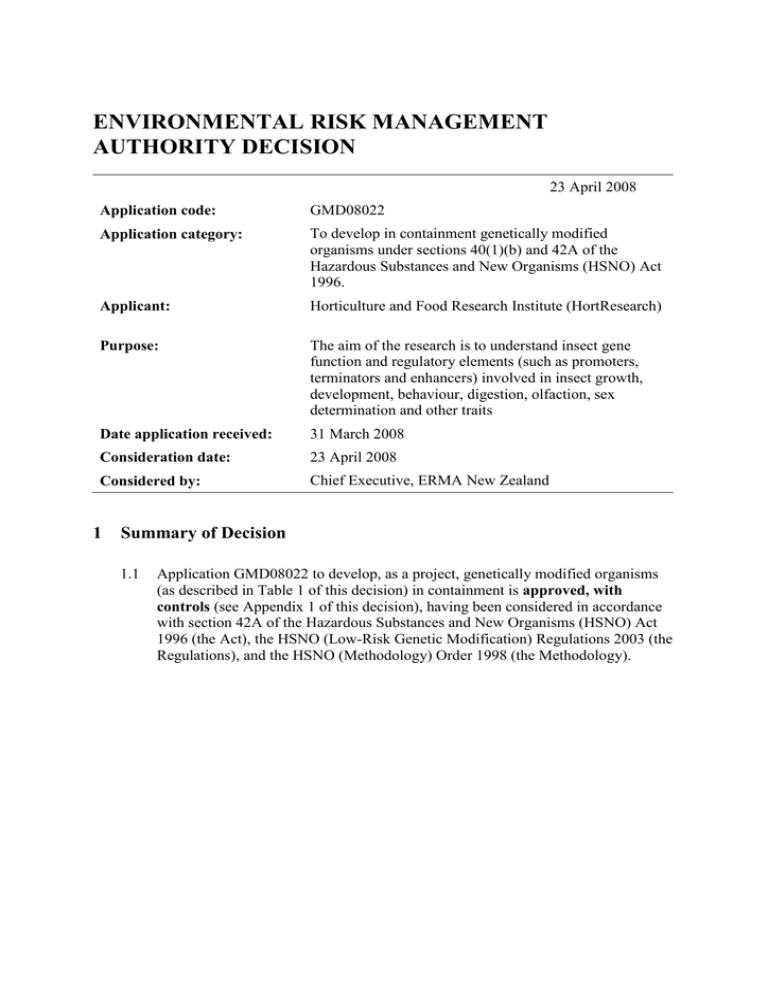
ENVIRONMENTAL RISK MANAGEMENT AUTHORITY DECISION 23 April 2008 Application code: GMD08022 Application category: To develop in containment genetically modified organisms under sections 40(1)(b) and 42A of the Hazardous Substances and New Organisms (HSNO) Act 1996. Applicant: Horticulture and Food Research Institute (HortResearch) Purpose: The aim of the research is to understand insect gene function and regulatory elements (such as promoters, terminators and enhancers) involved in insect growth, development, behaviour, digestion, olfaction, sex determination and other traits Date application received: 31 March 2008 Consideration date: 23 April 2008 Considered by: Chief Executive, ERMA New Zealand 1 Summary of Decision 1.1 Application GMD08022 to develop, as a project, genetically modified organisms (as described in Table 1 of this decision) in containment is approved, with controls (see Appendix 1 of this decision), having been considered in accordance with section 42A of the Hazardous Substances and New Organisms (HSNO) Act 1996 (the Act), the HSNO (Low-Risk Genetic Modification) Regulations 2003 (the Regulations), and the HSNO (Methodology) Order 1998 (the Methodology). The organisms approved are: 1.2 The organisms approved for development are the genetically modified organisms described in Table 1: Table 1: Organisms as recorded on ERMA New Zealand Register Host organism Category Modified by: of host organism Escherichia coli (Castellani and Chalmers, 1919) non- pathogenic laboratory strains Pichia pastoris (Guillierm.) Phaff 1956 non-pathogenic laboratory strains Pichia methanolica Makig. 1974 non-pathogenic laboratory strains 1 1 1 Standard non-conjugative E. coli cloning and expression plasmid vectors, E. coli/yeast cloning and expression shuttle vectors, phagemids and bacmids, containing genomic DNA or complementary DNA (cDNA) derived from lepidopteran, coleopteran, hemipteran, orthopteran, hymenopteran and dipteran insects as listed below this table. The genetic material will consist of genes and regulatory elements involved in functions such as insect growth, development, behaviour, digestion, olfaction, reproduction, sex determination, gene regulation and insecticide resistance. Category of modification/ containment level A/PC1 A/PC1 A/PC1 For constructing insect transformation vectors, using E. coli as an intermediary host: Insect transformation plasmid vectors which may contain sequences derived from transposons and transposable elements such as piggyBac, Minos and mariner, and/or insect viral sequences. Plasmid vectors developed for transient expression of bacteriophage integrase, and transposase enzymes with the associated gene regulatory elements. The genetic material will consist of coding, non-coding and/or regulatory regions, antisense sequences or other RNA interference-inducing sequences for genes with known or predicted functions in insect growth, development, behaviour, digestion, olfaction, reproduction, sex determination, Environmental Risk Management Authority Decision: Application GMD08022 Page 2 of 14 gene regulation and insecticide resistance, derived from the insects listed below this table. Vector information and exclusions are listed below this table. Epiphyas postvittana (Walker, 1863), Spodoptera litura (Fabricius, 1775), Helicoverpa amigera (Hubner, 1805), Drosophila melanogaster (Meigen, 1830), Cydia pomonella (Linnaeus, 1758), Hofmannophila pseudospretella (Stainton, 1849), Tineola bisselliella (Hummel, 1823), Phthorimaea operculella. (Zeller, 1873), Scolypopa australis (Walker), Myzus persicae (Sulzer), 2 Random or targeted insertions of insect transformation plasmid vectors which may contain sequences derived from transposons and transposable elements such as piggyBac, Minos and mariner, and/or insect viral sequences. Plasmid vectors developed for transient expression of bacteriophage integrase, and transposase enzymes with the associated gene regulatory elements will be co-injected as separate plasmids. B/PC2 The genetic material will consist of coding, non-coding and/or regulatory regions, antisense sequences or other RNA interference-inducing sequences for genes with known or predicted functions in insect growth, development, behaviour, digestion, olfaction, reproduction, sex determination, gene regulation and insecticide resistance, derived from the insects listed below this table. The genetic sequence may be altered to increase expression in a heterologous host; including codon preference changes, initiator and terminator codon context changes, removing or altering intron sequences or splice site recognition sequences Vector information and exclusions are listed below this table. Teleogryllus commodus (Walker), Apis mellifera (Linnaeus) (Whole insects) Environmental Risk Management Authority Decision: Application GMD08022 Page 3 of 14 List of genera of insects that will be used as sources of genetic material (genomic DNA, RNA and cDNA) Lepidopteran insects: Tortricid family including Epiphyas postivittana and Cydia pomonella. Noctuid family including Helicoverpa armigera and Spodoptera litura. Oecophorid family including Hofmannophila pseudospretella. Teneid family including Tineola bisselliella. Gelechilid family including Phthorimaea operculella. Lymantrid family including Teia anartoides Bombyxicid family including Bombyx mori Orygid, Hyponomeutid, Pierid, Hepialid, Geometrid and Pyralid families Coleopteran insects: Scarabaeid, Cerambycid, Chrysomelid, Bruchid, Tenebrionid and Curculonid families Hemipteran insects: Aphidid, Pentatomid, Ricaniid, Mirid, Eriococcid, Coccid and Diaspid families including Scolypopa australis and Myzus persicae Orthopteran insects: Gryllid and Acridid families including Telleogryllus commodus Hymenopteran insects: Siricid, Formicid, Vespid and Apid families including Apis mellifera Dipteran insects: Cecidomycid, Calliphorid, Muscid, Drosophilid and Culicid families including Drosophila melanogaster Genetic modifications will exclude: Expression of genes encoding known or suspected vertebrate toxins with an LD50 < 100 µg/kg. Genetic material derived from CITES listed species. Genetic material derived from native insect species. Vectors used in genetic modification: Vectors will include standard or fully characterised regulatory elements including promoters, regulatory element binding sites, transcriptional activators, enhancers, terminators, and multiple cloning sites and origins of replication. The vectors may also contain selectable marker genes, reporter genes, protein targeting, localisation and secretory signals, solubility enhancement tags, protein purification tags and affinity tags including epitope tags. Environmental Risk Management Authority Decision: Application GMD08022 Page 4 of 14 2 Consideration Sequence of the consideration 2.1 The application was formally received and verified as containing sufficient information on 31 March 2008. 2.2 The applicant was requested to provide further information as provided for under section 52 of the Act on 8 April 2008. This information was received on the 22 April 2008. 2.3 The decision was based on the information supplied by the applicant in the application form: Develop in containment a project of low risk genetically modified organisms by rapid assessment (NO3P). 2.4 The application was considered by Rob Forlong, the Chief Executive of ERMA New Zealand. Relevant staff within ERMA New Zealand, including the General Manager, Māori, were involved in providing advice on the consideration of the application. 2.5 In reaching my decision I have considered matters relevant to the purpose of the Act, as specified in Part II, and followed the relevant provisions of the Methodology. 2.6 In accordance with section 42A of the Act for rapid assessment, the approach adopted was to identify the circumstances of the genetic modification, to evaluate these against the criteria specified in the Regulations established under section 41 of the Act, and to consider whether there are any residual risks that require further consideration. This approach covered the following issues: purpose of the application (section 39 of the Act); assessment against the criteria of the Regulations; identification and assessment of the risks and other impacts of the organism; precedents; and containment controls. Environmental Risk Management Authority Decision: Application GMD08022 Page 5 of 14 Purpose of the application 2.7 The aim of the research is to understand insect gene function and regulatory elements (such as promoters, terminators and enhancers) involved in insect growth, development, behaviour, digestion, olfaction, sex determination and other traits. The research involves two components, firstly to analyse insect genes and the protein made from these genes, to determine their function in insect development and biochemical processes. The second part involves making transgenic or genetically modified insects that either express forms of the gene of interest, or reduce or abolish the expression of the gene of interest, to study their function in vivo. 2.8 The knowledge gained from this research will offer the potential of developing new methods of influencing insect development, behaviour, physiology and other traits and thus allow the control of pest species on horticultural crops. 2.9 I have determined that this application is for a valid purpose being the development of any new organism as provided for in section 39(1)(a) of the Act. Assessment against the criteria for low-risk genetic modification Category of host organism 2.10 The non-pathogenic laboratory strains of E. coli, P. pastoris and P. methanolica to be used by the applicant are not capable of causing disease in humans, animals, plants or fungi, normally infect, colonise, or establish in humans, nor do they produce desiccation-resistant structures, such as spores or cysts. As such, E. coli, P. pastoris and P. methanolica are considered Category 1 host organisms as defined in clause 7(1) of the Regulations. 2.11 The insects E. postvittana, S. litura, H. amigera, D. melanogaster, C. pomonella, H. pseudospretella, T. bisselliella, P. operculella, S. australis, M. persicae, T. commodus and A. mellifera are Category 2 host organisms as defined in clause 7(2) of the Regulations, as these are whole insects. Environmental Risk Management Authority Decision: Application GMD08022 Page 6 of 14 Category of genetic modification 2.12 The genetic modifications to E. coli, P. pastoris and P. methanolica (described in Table 1) are not expected to increase the pathogenicity, virulence or infectivity of the organisms to laboratory personnel, the community, or the environment. In addition, the developments will not result in the organisms having a greater ability to escape from containment than the unmodified organisms. Therefore, the genetic modifications to E. coli, P. pastoris and P. methanolica as described in Table 1 of this decision are Category A genetic modifications as defined in clause 5(1) of the Regulations and shall be contained at a minimum of Physical Containment level 1 (PC1). 2.13 The genetic modifications to the insects, E. postvittana, S. litura, H. amigera, D. melanogaster, C. pomonella, H. pseudospretella, T. bisselliella, P. operculella, S. australis, M. persicae, T. commodus and A. mellifera (described in Table 1) are not expected to increase the pathogenicity, virulence or infectivity of the organisms to laboratory personnel, the community, or the environment. In addition, the developments will not result in these insect having a greater ability to escape from containment than the unmodified organisms. Therefore, the genetic modifications to the whole insects as described in Table 1 of this decision are Category B genetic modifications as defined in clause 5(2) of the Regulations and shall be contained at a minimum of Physical Containment level 2 (PC2). 2.14 I am satisfied that the developments meet the criteria for low-risk genetic modification specified in the Regulations. The developments involving E. coli, P. pastoris and P. methanolica meet the requirements of Category A modifications as defined in clause 5(1) of the Regulations. The developments involving the whole insects (listed in Table 1) meet the requirements of Category B modifications as defined in clause 5(2) of the Regulations. Identification and assessment of the risks, costs and other impacts of the organism 2.15 I consider that the information provided by the applicant is relevant and appropriate to the scale and significance of the risks, costs, and benefits associated with the application (as required by clause 8 of the Methodology). In accordance with clauses 9, 10 and 12 of the Methodology (which incorporate sections 5, 6, and 8 of the Act) the information supplied by the applicant has been evaluated as follows: 2.16 I consider that, given the biological characteristics of the organisms, the containment system and the controls attached to this approval (see Appendix 1 of this decision), there is no evidence for, nor any reason to expect, any nonnegligible adverse effects of the proposed genetically modified organisms on humans, animals, plants, other organisms or the environment. Environmental Risk Management Authority Decision: Application GMD08022 Page 7 of 14 2.17 I have considered the potential Māori cultural effects in accordance with sections 6(d) and 8 of the Act and clauses 9(b)(i), 9(c)(iv) of the Methodology, in consultation with the General Manager, Māori. As this application does not involve the use of genetic material from native or valued flora and fauna or from Māori, and as this application is for a development in containment, there is no requirement for the applicant to consult with Māori. 2.18 Although recognising that iwi/Māori maintain an ongoing interest and concern in the potential long term cultural implications of genetic modification generally, I consider that this application poses negligible risk of adverse effects to the relationship of Māori culture and traditions with their ancestral lands, water, sites, waahi tapu, valued flora and fauna, and other taonga. 2.19 This assessment is made with the understanding that all associated containment regulations, controls and conditions are met by the applicant. Precedents 2.20 I must consider each application on its merits, and am therefore not bound by the stance taken in previous decisions. However, in reflecting on previous decisions that involved similar genetic modifications to those proposed by this application, I note that genetic modifications involving these non-pathogenic E. coli, P. pastoris and P. methanolica for the purpose of expressing foreign proteins, have been considered and approved on several occasions by both Institutional Biological Safety Committees (IBSCs) and the Chief Executive of ERMA New Zealand, under delegated authority. 2.21 I note that this application is similar in purpose to application GMD06008, which is to understand insect gene function and regulatory elements, such as promoters, terminators and enhancers, involved in insect growth, development, behaviour, digestion, olfaction and other traits. However, unlike application GMD06008, which involves transient transfection of whole insects with recombinant DNA molecules, the host insects in this application will be genetically modified by the insertion of transgenes into the genome. 2.22 I consider that this current application does not raise any novel issues that would warrant it not to be considered via section 42A of the Act. Containment 2.23 The experiments proposed in this application to develop E. coli, P. pastoris and P. methanolica, meet the requirements of Category A genetic modifications as defined in clause 5(1) of the Regulations. Category A experiments are required to be contained within a Physical Containment level 1 facility (PC1). Environmental Risk Management Authority Decision: Application GMD08022 Page 8 of 14 2.24 The facility to be used for work involving E. coli, P. pastoris and P. methanolica shall be approved and registered as a containment facility under section 39 of the Biosecurity Act, in accordance with MAF/ERMA New Zealand Standard: Facilities for Microorgansisms and Cell Cultures: 2007. This containment regime contains clear guidelines for the safe handling and disposal of cultures. 2.25 The development of genetically modified whole insects, E. postvittana, S. litura, H. amigera, D. melanogaster, C. pomonella, H. pseudospretella, T. bisselliella, P. operculella, S. australis, M. persicae, T. commodus and A. mellifera, meet the requirements of Category B genetic modifications as defined in clause 5(2) of the Regulations. Category B experiments are required to be contained within a Physical Containment level 2 facility (PC2). 2.26 The facility to be used for work involving whole insects shall be registered to the MAF/ERMA New Zealand Standard Transitional and Containment Facilities for Invertebrates, and comply with the requirements within the relevant sections of the Australian New Zealand Standard AS/NZS 2243.3:2002. I consider the provisions within that Standard requiring all insect and biological waste to be made nonviable prior to disposal, to be adequate to ensure that the experimental organisms approved by this decision, are fully contained. 2.27 The applicant has proposed to monitor the growth and development of transgenic insects through all life stages, including the ability of these insects to complete their life cycle on host plants in containment. I note that it may be practical to perform these exposure experiments in PC2 facility registered to MAF/ERMA New Zealand Standard Containment Facilities for Plants: 2007. However, in order to ensure adequate containment of the genetically modified insects, this containment facility would still be required to be registered to MAF/ERMA New Zealand Standard: Transitional and Containment Facilities for Invertebrates at PC2. 3 Decision 3.1 I am satisfied that this application is for one of the purposes specified in section 39(1) of the Act, being section 39(1)(a): the development of any new organism. 3.2 Based on consideration and analysis of the information provided, and having considered the characteristics of the organisms that are the subject of this approval, the modifications and the criteria for low-risk genetic modification detailed in the Regulations, I am of the view that the organisms meet the criteria for rapid assessment under section 42A of the Act. 3.3 I have considered all the matters to be addressed by the containment controls for Importing, Developing or Field testing of Genetically Modified Organisms detailed in the Third Schedule Part I, of the Act, and in accordance with section 42A(3)(b), this approval is subject to the controls specified in Appendix 1. Environmental Risk Management Authority Decision: Application GMD08022 Page 9 of 14 3.4 I consider that this current application does not raise any novel issues. 3.5 Pursuant to section 42A(3)(a) of the Act, and acting under delegation from the Authority provided for in section 19 of the Act, I have approved this project application for genetically modified microorganisms and whole insects, as described in Table 1 of this decision, subject to the controls specified in Appendix 1 of this decision. ___________________________ Mr Rob Forlong 23 April 2008 Date Chief Executive, ERMA New Zealand Approval codes (BCH numbers): GMD005107 – 21 (44920 – 34) Environmental Risk Management Authority Decision: Application GMD08022 Page 10 of 14 Approval numbers and BCH numbers for Organisms in Application GMD08022 Approval Code GMD005107 GMD005108 GMD005109 GMD005110 GMD005111 GMD005112 GMD005113 GMD005114 GMD005115 GMD005116 GMD005117 GMD005118 GMD005119 GMD005120 GMD005121 Organism Apis mellifera (Linnaeus) (GMD08022) Cydia pomonella (Linnaeus, 1758) (GMD08022) Drosophila melanogaster (Meigen, 1830) (GMD08022) Epiphyas postvittana (Walker, 1863) (GMD08022) Escherichia coli (Migula 1895) Castellani & Chalmers 1919 (GMD08022) Helicoverpa amigera (Hubner, 1805) (GMD08022) Hofmannophila pseudospretella (Stainton, 1849) (GMD08022) Myzus persicae (Sulzer) (GMD08022) Phthorimaea operculella (Zeller, 1873) (GMD08022) Pichia methanolica Makig., (1974) (GMD08022) Pichia pastoris Guillerm Phaff (1956) (GMD08022) Scolypopa australis (Walker) (GMD08022) Spodoptera litura (Fabricius, 1775) (GMD08022) Teleogryllus commodus (Walker) (GMD08022) Tineola bisselliella (Hummel, 1823) (GMD08022) Environmental Risk Management Authority Decision: Application GMD08022 BCH number 44920 44921 44922 44923 44924 44925 44926 44927 44928 44929 44930 44931 44932 44933 44934 Page 11 of 14 Appendix 1: Controls required by this approval In order to provide for the matters detailed in Part I of the Third Schedule of the Act1, Containment Controls for Importation, Development and Field Testing of Genetically Modified Organisms, and other matters in order to give effect to the purpose of the Act, the approved organisms are subject to the following controls: 1 To limit the likelihood of any accidental release of any organism or any viable genetic material2. 1.1 The approved organism shall be developed and maintained within a containment facility which complies with these controls. 1.2 The person responsible for a particular research area and/or the person responsible for the operation of the containment facility shall inform all personnel involved in the handling of the organism of the Authority’s controls. 1.3 The facility shall be approved and registered by MAF as a containment facility under section 39 of the Biosecurity Act, in accordance with the MAF/ERMA New Zealand Standard (below), and controls imposed by the Authority (as follows): 1.4 The construction, operation and management of the containment facility shall be in accordance with the: 1.4.1 MAF/ERMA New Zealand Standard: Facilities for Microorgansisms and Cell Cultures: 20073 for the genetic modification of E. coli, P. pastoris and P. methanolica; 1.4.2 MAF/ERMA New Zealand Standard Transitional and Containment Facilities for Invertebrates3 for the genetic modification of whole insects; 1.4.3 Australian/New Zealand Standard AS/NZS 2243.3:20023: Safety in laboratories: Part 3: Microbiological aspects and containment facilities; 1.4.4 Physical Containment level 1 (PC1) requirements of the above Standards for developments involving E. coli, P. pastoris and P. methanolica; and 1 Bold headings in the following text refer to Matters to be Addressed by Containment Controls for Import, Development and Field Testing of Genetically Modified Organisms, specified in the Third Schedule of the Act. 2 Viable Genetic Material is biological material that can be resuscitated to grow into tissues or organisms. It can be defined to mean biological material capable of growth even though resuscitation procedures may be required, e.g. when organisms or parts thereof are sub-lethally damaged by being frozen, dried, heated, or affected by chemical. 3 Any reference to this standard in these controls refers to any subsequent version approved or endorsed by ERMA New Zealand. Environmental Risk Management Authority Decision: Application GMD08022 Page 12 of 14 1.4.5 Physical Containment level 2 (PC2) requirements of the above Standards for developments involving whole insects. 2 2.1 3 3.1 4 4.1 5 To exclude unauthorised people from the facility. Construction and operation of the containment facility shall comply with the requirements of the standards listed in control 1.4 relating to the identification of entrances, numbers of and access to entrances and security requirements for the entrances and the facility. To exclude other organisms from the facility and to control undesirable and unwanted organisms within the facility. Construction and operation of the containment facility shall comply with the requirements of the standards listed in control 1.4 relating to the exclusion of other organisms from the facility and the control of undesirable and unwanted organisms within the facility. To prevent unintended release of the organism by experimenters working with the organism. Construction and operation of the containment facility shall comply with the requirements of the standards listed in control 1.4 relating to the prevention of unintended release of the organism by experimenters working with the organism. To control the effects of any accidental release or escape of an organism. 5.1 Construction and operation of the containment facility shall comply with the requirements of the standards listed in control 1.4 relating to controlling the effects of any accidental release or escape of an organism. 5.2 If a breach of containment occurs, the facility operator must ensure that the MAF Inspector responsible for supervision of the facility has received notification of the breach within 24 hours. 5.3 In the event of any breach of containment of the organism, the contingency plan for the attempted retrieval or destruction of any viable material of the organism that has escaped shall be implemented immediately. The contingency plan shall be included in the containment manual in accordance with the requirements of standards listed in control 1.4. Environmental Risk Management Authority Decision: Application GMD08022 Page 13 of 14 6 Inspection and monitoring requirements for containment facilities. 6.1 The operation of the containment facilities shall comply with the requirements contained in the standards listed in control 1.4 relating to the inspection and monitoring requirements for containment facilities. 6.2 The containment manual shall be updated, as necessary, to address the implementation of the controls imposed by this approval, in accordance with the standards listed in control 1.4. 7 7.1 Qualifications required of the persons responsible for implementing those controls. The training of personnel working in the facility shall be in compliance with the standards listed in control 1.4. Environmental Risk Management Authority Decision: Application GMD08022 Page 14 of 14
